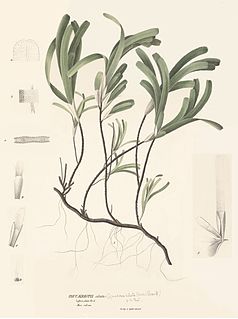
Chamelaucium, also known as waxflower, is a genus of shrubs endemic to south western Western Australia. They belong to the myrtle family Myrtaceae and have flowers similar to those of the tea-trees (Leptospermum). The most well-known species is the Geraldton Wax, Chamelaucium uncinatum, which is cultivated widely for its large attractive flowers.

Thalassodendron is a genus of seagrass in the family Cymodoceaceae described as a genus in 1970. It grows along the shores of the Indian Ocean and the western Pacific Ocean.

Epilobium ciliatum, known by the common names fringed willowherb, American willowherb, slender willow herb, and northern willow herb is a species of flowering plant in the willowherb family Onagraceae. This species is native to much of North America, southern South America, and East Asia. It is an introduced species in much of Eurasia and Australia.

Rhododendron ciliatum (睫毛杜鹃) is a rhododendron species native to eastern Nepal, Sikkim, Bhutan, southern Tibet, and Xizang in China, where it grows at altitudes of 2700–3500 meters. It is a shrub that grows to 0.3–2 m in height, with leathery leaves that are elliptic or oblong-elliptic to oblong-lanceolate, 3–8 by 1.6–3.7 cm in size. Flowers are white tinged with pink.

Thalassodendron ciliatum, the sickle-leaved cymodocea, is a species of plant in the Thalassodendron genus of seagrasses in the family Cymodoceaceae.

Hakea lehmanniana, commonly known as the blue hakea, is a shrub in the family Proteacea. It has needle-shaped prickly leaves and blue flowers during winter months. It is endemic to an area in the southern Wheatbelt and Great Southern regions of Western Australia.
Synaphea polymorpha, commonly known as Albany synaphea, is a species of small shrub in the flowering plant family Proteaceae. It is endemic to Western Australia. The Noongar peoples know the plant as bindak.
Conospermum cinereum is a shrub endemic to Western Australia.
Conospermum croniniae is a shrub endemic to Western Australia.
Conospermum filifolium is a shrub endemic to Western Australia.
Conospermum floribundum is a shrub endemic to Western Australia.
Conospermum multispicatum is a shrub endemic to Western Australia.
Petrophile aspera is a shrub endemic to Western Australia.
Petrophile cyathiforma is a shrub endemic to Western Australia.
Petrophile helicophylla is a shrub endemic to Western Australia.
Stirlingia anethifolia is a shrub endemic to Western Australia.
Synaphea divaricata is a shrub endemic to Western Australia.
Synaphea floribunda is a shrub endemic to Western Australia.
Synaphea interioris is a shrub endemic to Western Australia.
Synaphea preissii is a shrub endemic to Western Australia.





